Author: Faust, Geek Web3
On August 25th, L2BEAT, a well-known Ethereum Layer2 research institution, announced that it would rename Optimistic Chain to Optimium (OP Rollup without using ETH as the DA layer), highlighting the distinction between OP Rollup and Optimium. At the same time, L2BEAT added a “Show rollups only” button on the homepage of its website, allowing visitors to hide information related to Validium and Optimium, and directly differentiate Rollups from scalability networks that do not use ETH to achieve data availability.
L2BEAT even stated that it will soon be able to remove the TVL data of Validium and Optimium from the visualization dashboard of Layer2 TVL, and only display the TVL data of Rollups.
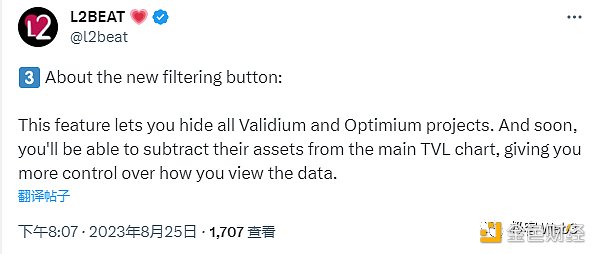
- Unable to defend against Why are a large number of encrypted Twitter accounts hacked to post phishing links? How to prevent it?
- Why do application developers choose Anoma to build CoFi applications?
- Finding the ‘Holy Grail’ of the blockchain gaming track in the next bull market
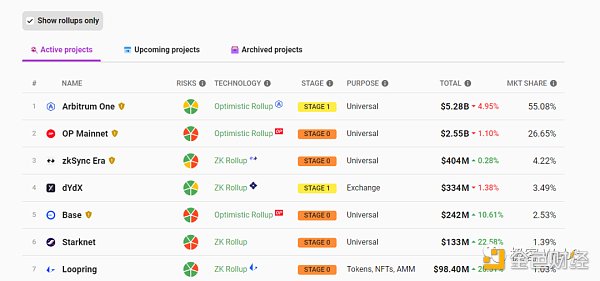
This approach is particularly interesting. Just two weeks ago on August 10th, Dankrad, a member of the Ethereum Foundation and the proposer of Danksharding, expressed his views on “what is Layer2,” stating that modular blockchains that do not use ETH as the DA layer are not Rollups, and therefore not Layer2. He also specifically mentioned Validium (a ZK Rollup that does not publish DA data on Ethereum) and claimed that it has security vulnerabilities in the comments section of his tweet.
Dankrad’s controversial remarks have sparked heated discussions within the Ethereum community, with many members of major Layer2 projects participating. Many outsiders have also begun to contemplate the essence of Layer2: what exactly is “Layer2”?
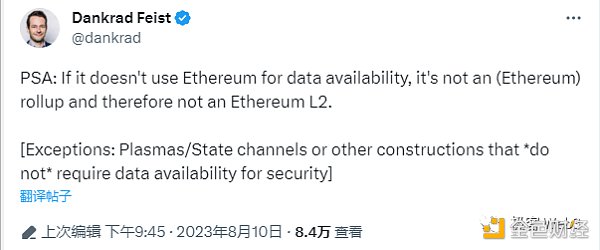
In fact, this is a subjective and difficult-to-conclude issue, similar to the conflict between the Catholic Church and the Protestants in the 16th century. Different stakeholders consider it from their own perspectives and thus have different opinions. However, for phenomena similar to conflicts between religious denominations, mainstream public opinion still values the official statement of the Ethereum Foundation. Even though there are a hundred different opinions, people are more willing to believe the most authoritative statement (the Catholic Church has the most authoritative interpretation of the Bible).

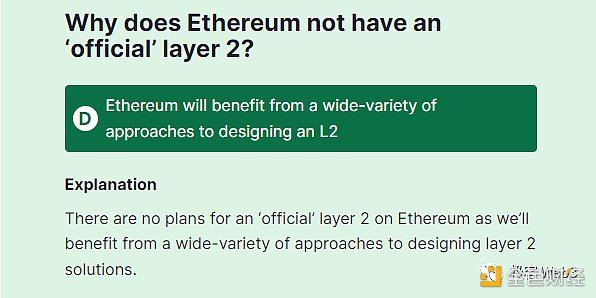
However, on the Ethereum official website – ethereum.org, there is no specific and strict definition of “which projects are Layer2 and which projects are not Layer2.” In fact, it directly states that “there is currently no official definition of Layer2.” But in some paragraphs, it states the following: “Sidechains and Validium expand Ethereum in a similar way to Layer2… but with different trust assumptions…” “Sidechains and Validium cannot obtain security or data availability from Ethereum.”

These statements seem to imply that scalability solutions other than Validium and Optimium Rollups are not Layer2. However, when combined with the earlier statement “there is currently no official definition of Layer2,” these two statements become contradictory. Regarding this, I even had ChatGPT 4 analyze the Ethereum Foundation’s thoughts, and the response I received was as follows:
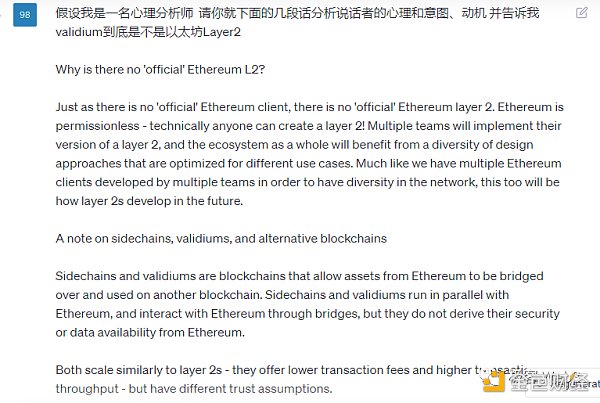
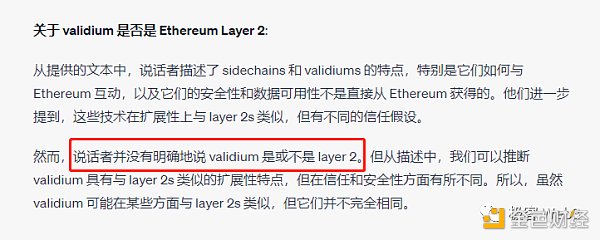
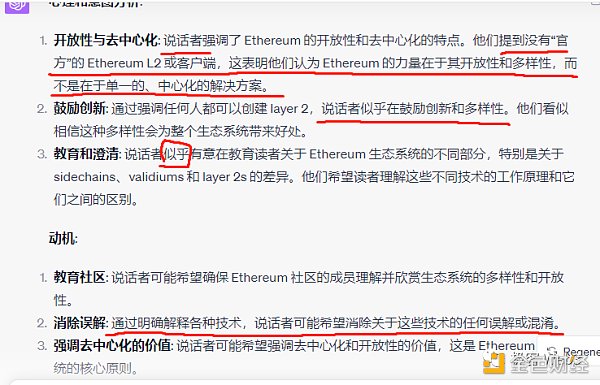
Obviously, although the Ethereum official intends to distinguish Validium, sidechains, and Layer2, it does not directly say “Validium is not Layer2”. This somewhat ambiguous attitude may encourage scaling projects within the ecosystem to propose various solutions, thereby promoting innovation. Once Validium or Optimium is denied with a radical and decisive attitude, it will undoubtedly hurt the feelings of related project parties and discourage their enthusiasm (after all, many projects come to the Ethereum ecosystem for the sake of Layer2).
However, Dankrad, a member of the Ethereum Foundation, now explicitly states that Validium is not Layer2. Although this attitude is clear, it seems more like “leaking wind”, and other core members of the Ethereum Foundation have not followed Dankrad’s footsteps to launch attacks. The “new initiative of L2BEAT” mentioned earlier also easily makes observers feel the “subtle” stance of the Ethereum community. Although the foundation has not officially and firmly “excluded” scaling solutions outside of Rollup, these series of signs inevitably make people think of certain possibilities.
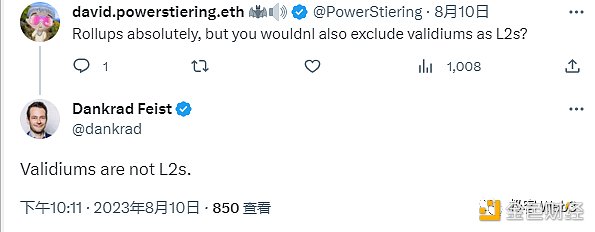
In response to this, a developer from a non-Rollup scaling project believes that L2BEAT to some extent commits dogmatism and somewhat submits to authority on the issue of “orthodoxy”. He pointed out that not using ETH as the data availability layer but introducing other mechanisms to ensure high security can incorporate more innovative factors into the Layer2 system. Although non-Rollup scaling solutions may indeed have problems in extreme cases, the probability of this is extremely low, and it even only exists in theory rather than practice. The current “different perspective” of L2BEAT and even Dankrad on non-Rollup projects is actually stifling the innovation and inclusiveness of the Ethereum ecosystem.
Of course, because this developer is a stakeholder, he will inevitably take a stand from his own perspective. The Ethereum community and even the Ethereum Foundation stand on the position of safeguarding the interests and values of Ethereum itself, and it is not possible to be “absolutely fair” to people and things. Both sides are in a situation of “the insiders are confused, while the outsiders are clear”, which leaves some ambiguities.
For example, while Dankrad “excludes” Validium, he also says that “Plasma and state channels… are Layer2”.
However, in the official Ethereum website https://ethereum.org/, you can see the following statement: “However, the existence of Validium provides higher security for Validium than other pure off-chain scaling solutions (Plasma and sidechains).” (In fact, if we ignore the extreme cases of launching data withholding attacks and refusing user withdrawals in the off-chain data availability layer, Validium is indeed more secure than Plasma. And many technicians have made it clear that Plasma is already outdated and should not be considered as Layer2.)

Obviously, this is actually in conflict with Dankrad’s remarks. In order to avoid the impact of personal subjective speculation, the author of this article directly used Chatgpt4 to analyze these seemingly “contradictory” statements. It can be seen that Chatgpt4 also believes that Dankrad’s remarks are in conflict with the above statements from the Ethereum official website.
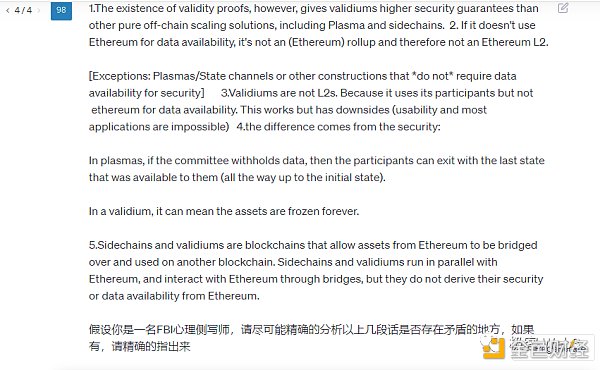
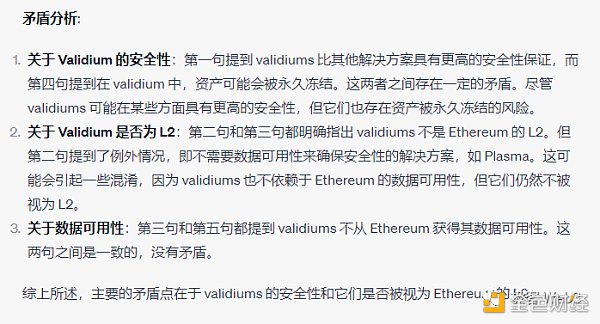
So, the key question is, why is there such a logical inconsistency and contradiction? In response to this, the author found a paragraph from Vitalik’s personal blog on January 5, 2021, and used this sentence as one of the materials for analysis by Chatgpt4.

At the same time, the author of this article made more precise processing of all the statements analyzed by Chatgpt4, marked the subject of each statement, and added a key assumption: it is known that Vitalik is the leader of the Ethereum Foundation, and Dankrad is a member of the Foundation, and he does not want to negate Vitalik’s views. And Vitalik once said, “The three major types of layer-2 scaling are state channels, Plasma, and rollups……”
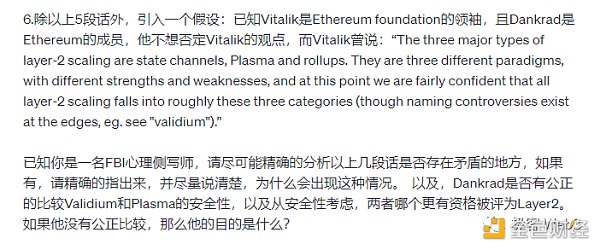
The result is very interesting, as shown in the figure below.
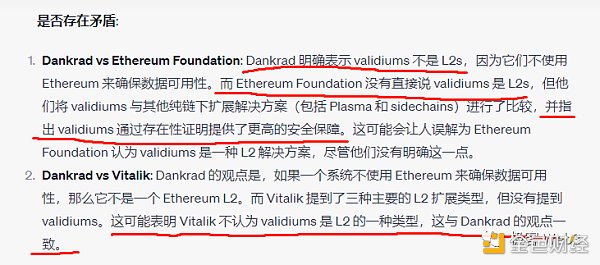
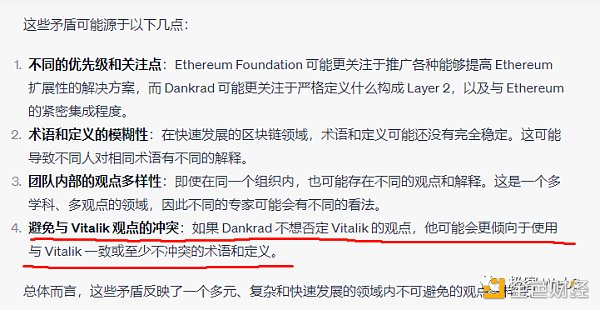
This analysis result prominently shows the words “avoid conflicting with Vitalik’s views.” And it shows that if Dankrad does not want to negate Vitalik’s views, he may be more inclined to use terminologies and definitions that are consistent with Vitalik’s or at least not in conflict. Of course, this result is based on the fact that the Ethereum official website has pointed out that Validium has stronger security guarantees than Plasma, and Vitalik once said, “The three major types of layer-2 scaling are state channels, Plasma, and Rollup,” but Dankrad does not want to negate Vitalik’s views. These three pieces of material.
The analysis result shown in the next figure is even more interesting, directly stating that Dankrad did not comprehensively compare the security of Validium and Plasma, but emphasized the difference between Plasma and Validium when off-chain data withholding occurs.



Later, the author repeatedly asked Chatgpt to analyze the above materials, and used the conclusions obtained above and the key materials used in the previous round of inferences as the materials for further iterative inferences by Chatgpt, and obtained relatively stable results.

The last sentence of the conclusion is quite interesting, it says, “His purpose seems to be to clarify the classification of the technology rather than to comprehensively compare the security of Validium and Plasma.”
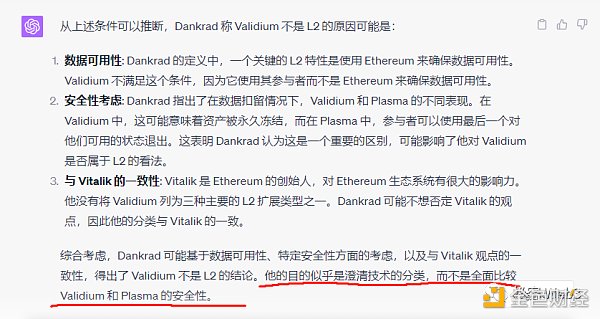
With this, the analysis of Chatgpt comes to an end. Looking back at the materials and inferences listed above, it is clear that Dankrad did not provide an objective and comprehensive analysis of the differences in security between Plasma and Validium, even though he analyzed their security in specific circumstances when distinguishing whether they are “Layer2”.
As for the purpose of doing so, Chatgpt points out: “It seems to clarify the classification of technology rather than a comprehensive comparison of security”, which is also thought-provoking. As for when the Ethereum community and even the Foundation will make a serious and high-profile response to the issue of the orthodoxy of Layer2, it is still unknown.
Like what you're reading? Subscribe to our top stories.
We will continue to update Gambling Chain; if you have any questions or suggestions, please contact us!